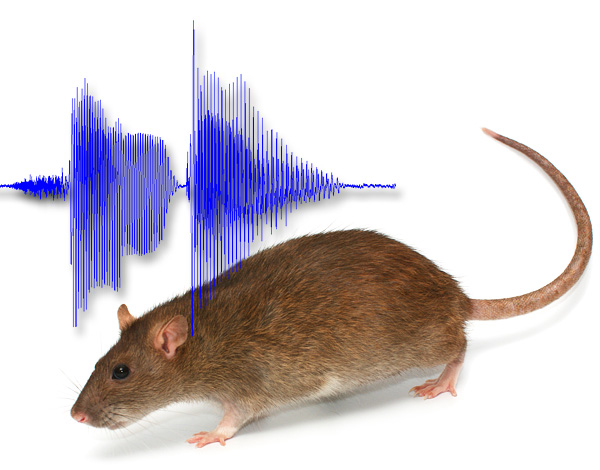
Needless to say, all kinds of electronic rodent repellers are at the peak of their popularity today. It is worth at least once to take an interest in this topic - and then on all sites you will be caught up with advertisements of ultrasonic, electromagnetic and magnetic resonance devices. And if you listen to the advertisement, almost every one of them is certainly positioned as the most effective and generating the very sound that scares away rats and mice. The sound, which (quote from one of the sites) "will make rodents forever forget the way to your house ..."
Well, the idea is really tempting: no need to poison the rats, no need to remove their carcasses with broken bones from the rat traps, no need to even get a cat. To scare away the rats from the house, it is enough to turn on a small “squeaker” in the socket - and, it seems, rodents in the room will no longer appear.
However, in reality, everything is not so simple. In fact, it turns out that a tool that really “squeaks,” that is, its sound is heard by a person, cannot scare away either rats or mice. Only ultrasonic repellents are effective against rodents, that is, such devices, the sound from which the human ear does not perceive (vibration frequency above 20,000 Hz).
Further, we will examine in more detail what specific sound is suitable for scaring away rats, but for now it’s worth noting even ultrasonic devices are effective through one, and many devices available on the market do not help to drive away rodents and generally have practically no effect on them.
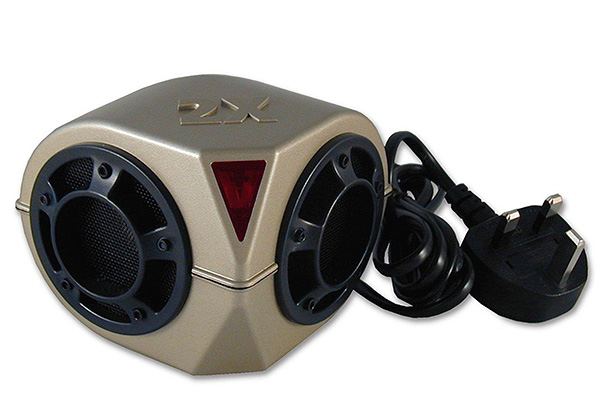
On a note
Sometimes people seriously expect to scare away rats using their mobile phone. The logic here is simple: why spend money on a special device if the sound can be played on a phone or, for example, a tablet? And if you download from the Internet and scroll exactly the sound that is unpleasant for rats and mice and which scares them away, then, it would seem, the animals in a panic should scatter from the room. Such sounds are really already recorded and laid out in the public domain.
However, the devil is here, as always, lurking in details: due to technical limitations, the phone will never replace a good repeller, since the speakers simply can not correctly reproduce ultrasound.
However, scaring rats out of the house is quite possible. And if you understand well what these animals are generally afraid of and how different devices work, then you can save a lot of time and money on fighting rodents.
What sounds are rats and mice afraid of?
Generally speaking, both rats and mice are afraid of sounds, not only in the ultrasonic range. First of all, they are afraid of quiet sounds - those that their natural enemies create (a sneaking cat, the sound of the wings of a bird of prey). The experiments showed that animals react to them more sharply and faster than to loud sounds: roar, the voices of people or even the sounds of explosions.
And this is understandable - most rats end their lives in the teeth and legs of cats, ferrets, snakes and falcons. These predators on the hunt just do not make noise, but try to move as silently as possible.

It has also been experimentally established that rats are frightened by any unfamiliar sounds. Not knowing whether they are a sign of danger or not, the animal will prudently avoid them, so as not to risk it until he realizes that these noises do not carry any threat. It can be sounds of completely different frequencies and volumes, the main thing is that they should not sound in this room before and the rats do not know them.
On a note
Therefore, by the way, a couple of times rats can be scared away with loud music or even screaming. But this will not give a long-term effect - the animals quickly get used to the musical predilections of the owners of the house and in the future they feel quite comfortable with daily concerts.
Finally, the third and most important type of sounds that scare away rats is the animal’s own signals, with which they alert each other about danger, or which they involuntarily emit during moments of aggression, intense fright, or in death agony. Such noises are most effective, since animals are afraid of them instinctively and rarely get used to them.

There is another important detail - many sounds from the “rat vocabulary” are not audible to humans. Rats and mice can hear and produce sounds with frequencies up to 70 kHz - their human ear does not perceive at all. Actually, that’s why they are called “ultrasound” (from the Latin ultra - over, above, overly, that is, they are beyond the range accessible to man).
It is such ultrasounds that are most convenient to use in the fight against rodents - creating discomfort for pests, they do not interfere with people at all. Agree, not every person (and even more so when it comes to neighbors) can stand listening to the loud squeak published by the device for days on end. If the ultrasound generator will work in the room, people will not hear it at all, but it will scare away the rats. If it is, of course, a good generator ...
On a note
Scientists have found that male mice attract females with ultrasonic songs as complex as birds' songs. Perhaps if we could hear such a singing, we would appreciate its beauty.
Of course, not every ultrasound scares rodents. In the entire ultrasonic range, there are also neutral frequencies for them, and causing discomfort. And the task of generating such a sound that really causes fear in rats, or is simply unpleasant for them, is quite complicated.
For example, in experiments, scientists found that rats are afraid of noise in the following frequency ranges:
- 25-28 kHz. So the rat cries when it feels pain;
- 32-33 kHz is a danger signal. It is published, for example, by a rat, which the cat is trying to catch;
- 35-60 kHz - in this range there is a “squeak” with which the animal simply expresses its discomfort.
(Of course, not only frequency is important here, but also signal modulation).

In mice, stress signals are also in several frequency ranges, the highest of which captures sounds with a frequency of 96 kHz.
So, to scare away rats and mice, you need to create such sounds from time to time in the room. But here, as always, there are several difficulties ...
How to scare off rats with sound?
The main problem in using ultrasound is that it is almost impossible to accurately guess the frequency at which rats will be afraid of it. Moreover, a device that will generate the same sound will most likely not be effective: animals will quickly get used to its signal.
In good repellers, this problem is solved simply: the frequencies in them are constantly changing, and the device periodically necessarily makes exactly those sounds that cause discomfort or even fear in rats and mice. Due to the fact that the frequency change occurs in a random mode (random), the animals cannot get used to either them or to the intervals between frightening signals, and therefore quickly cease to hover in a seemingly dangerous room.
The photo below shows an example of an ultrasonic rodent repeller Sititek 2D, for which this mode of operation is declared:
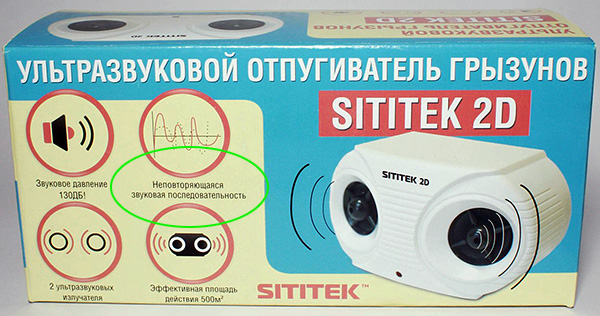
But to generate such a sound using improvised means is unlikely to succeed. There are no such household devices that would create rat repelling noises in the ultrasonic range, and even with a randomly changing frequency (even high-quality computer speakers are not designed to reproduce ultrasounds).
Good ultrasonic repellers are easier to buy than trying to do it yourself - you just need to be able to choose a really high-quality device. A few words about the choice of repeller are written below.
It is interesting
People still have livelihood methods of scaring away rodents.For example, it is believed that if a living rat is nailed to the wall of a barn, chicken coop or goat house, then the goods will definitely run away in horror from its dying screams. For the same purpose, someone is trying to burn rats alive indoors. The effectiveness of such methods is generally low: it is unlikely that they can mock animals every day, and a couple of days after the death of a tortured animal, his brethren will still return to the room. And just the cruelty of such methods makes them unacceptable for use.
Choosing an ultrasonic scaring device
The practice of fighters with rats and mice shows that repellers that cost more than 1000 rubles work reliably. In the case of these devices, the price reflects the level of quality quite well: cheaper than for 1000 rubles, usually obvious junk is sold, sometimes only simulating work due to the flashing of LEDs.
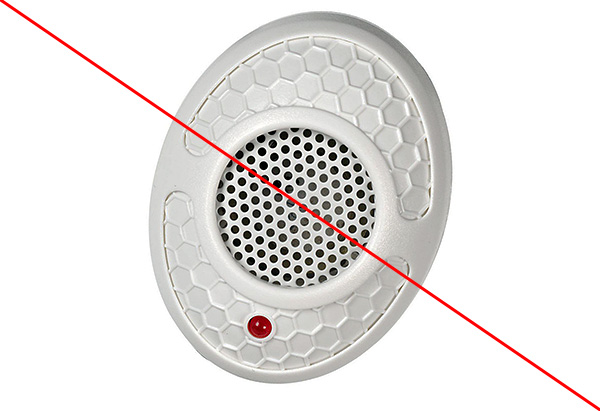
Moreover, several tens of devices were tested on basement and free-living rats at abandoned enterprises. It turned out that powerful and more or less reliable means by which you can scare off pests are:
- Chiston 2 (its price is approximately 2200 rubles);
- Chiston 2 missile defense (costs about 2500 rubles);
- Biostrazh (4500 rubles);
- TM-315 (costs more than 10,000 rubles);
- WK-0600 (7500 rubles);
- UZU-03 (costs about 3000 rubles);
- Range (3500 rubles);
- Tornado 800 (a popular device, the price is about 3500 rubles);
- Tsunami-2 (the most inexpensive from the list, costs a little less than 2000 rubles);
- KQ-202 A (about 8000 rubles).
The photo below shows the Chiston 2 repeller:
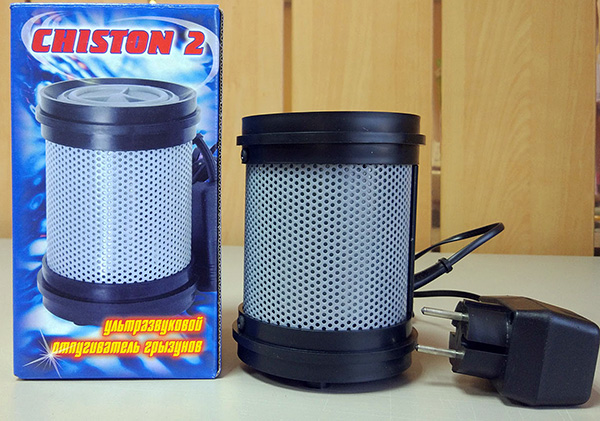
And here is the Tornado 800:
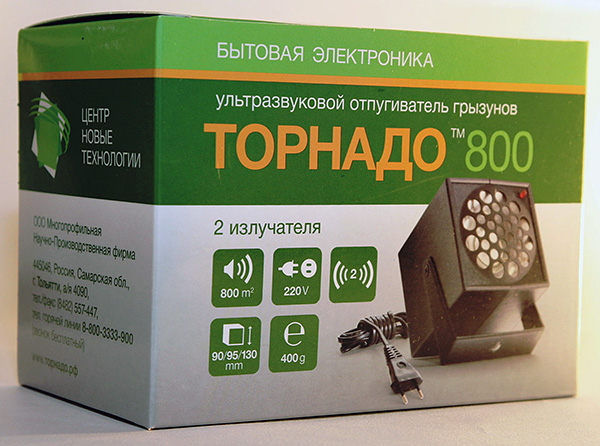
These devices are more likely to scare away rats from a large apartment or from a medium-sized private house, from a basement or technical room. However, even they sometimes do not give a visible effect.
On a note
You can also scare a rat using an ultrasonic dog shocker. However, you won’t be able to use such a tool all the time, since the battery runs out too quickly in it.
Sometimes devices of the brands Electrocot, Grad, Typhoon do not work, and sometimes they do not help. They look effective in reviews on YouTube, when the device is turned on directly in the cage with the mouse, however, in a large house, the power of the repeller can be insufficient.
Can I use a computer or phone to scare away rats?
A logical thought may come to the mind of a modern active user of electronic gadgets: whether to try to scare away rats with sound recorded on a phone or computer?
In fact, this idea is not new, but has already managed to fail repeatedly. First of all, because the dynamics of most devices "for people" are not designed to reproduce ultrasound. And not only the speakers, but the electronic part itself (amplifier) is not designed for such frequencies.
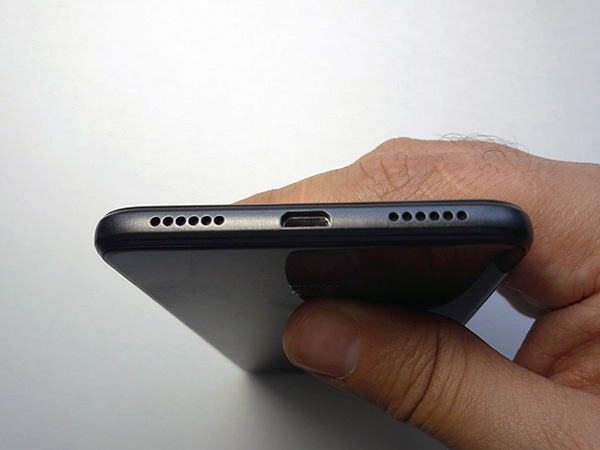
In addition, the power of the speakers of mobile devices is poor. "Ultrasonic" squeak from them already at the end of the average size of the room will hardly be heard.
However, sounds supposedly scaring rats out of the house are already recorded in mp3. For the sake of interest, you can download them and try to play them on your phone:
Download a sound supposedly scaring rats and mice
Another scare sound option (20,000 Hz)
Just remember that it is ultrasound that scares the rats, which the human ear does not perceive. So, if a distinctive squeak is recorded in mp3, then there is practically no hope for it.
On a note
For those who like to experiment, today even developed an application for the phone (smartphone), which is called - “rat Repeller”. This program not only generates sounds, but also changes their frequencies.
What else are rats afraid of and how can they be scared away?
Of course, rats are not only afraid of sounds. For example, they also avoid many odors, and they also try to use it to get rid of annoying rodents.

For example, it is known that rats are scared away:
- Technical liquids with strong odors - gasoline, kerosene, turpentine, malathion, vinegar, methylated spirit;
- Aromas of certain herbs (e.g. black root);
- Strong odors of perfumes, including essential oils.
However, there is a nuance - pests quickly get used to these tools. For example, if today turpentine or camphor oil discourages rats in the house, then after about a week the animals will be completely indifferent to it.
The main minus of these funds is that their smell in the house is well felt by a person. So that the rats do not dare to enter the premises, it should smell so much (in fact, stink) with gasoline or black root that people themselves can not live in such conditions. That is why such tools are rarely used: a sane person will not want to sacrifice comfort.
On a note
A cat is a good but not always effective protector of a house from rats. If she is really a rat trap, then you will know about the presence of rodents only from the corpses that the pet will wear for you to praise. If the rats understand that the cat will not catch them (in fact, there are a lot of such cats), then they will feel free to visit the house, no matter how much it smells of a cat's toilet.
What exactly does not work out to scare away rats?
Finally, it’s almost certain that you won’t be able to scare away the rats with numerous cheap Chinese scarers that are actively selling over the Internet. In fact, these tools do nothing, often their task is to simply blink a light bulb so that the user thinks that the device is working. They are bought in the hope of saving, and on the assumption that if the device does not help, then the money spent will not be a pity. Actually, that's exactly what happens.
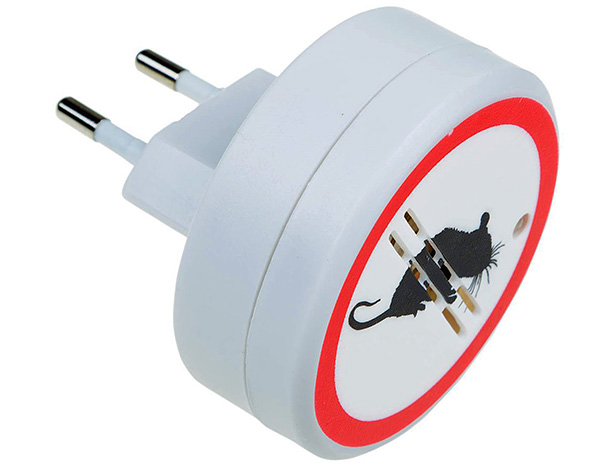
It is useful to pay attention to the operation of the purchased repeller: if the device, declared as ultrasonic, clearly beeps, then it has nothing to do with ultrasound. Consequently, he is unlikely to drive rats out of the house.
The so-called magnetic resonance and electromagnetic devices, which supposedly create a field in the electrical network of the apartment that repels insects and rodents, are also useless. There is no theoretical explanation for this effect, in practice, people find that rats and mice do not pay attention to such devices at all.
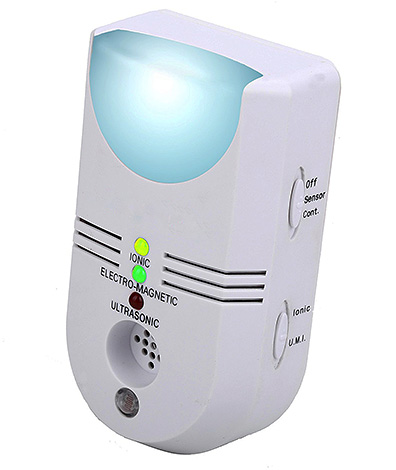
On a note
Another sure sign of an ineffective repeller is a statement from the manufacturer or seller that the device is supposedly universal, and repels all parasites and pests in the house in general - not only rats, but also bugs, cockroaches, wood lice, flies ...
Various folk remedies are almost always useless. For example:
- Elder;
- Broken glass poured near rat passages;
- Black beans;
- Red pepper, also scattered near rat shelters;
- Ash;
- Singed fur;
- Burned rubber ...
At best, these agents may cause some alertness in rats, but not for long. The animals quickly get used to it, and they do not leave the house.
If you have personal experience of scaring away rodents from home (in any way) - be sure to share the information by leaving a review at the bottom of this page.
Interesting video: ultrasound on Android
An example of how rodents do not pay any attention to a working repeller

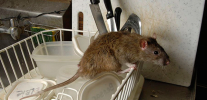
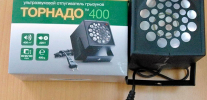
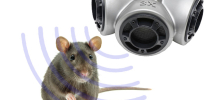
As for rat scaring away by sound - this theory is yours, but in practice I got the following. I came across an android application for scaring away. And there are modulated frequencies, and there are several of them, and all of them are not so much in ultrasound, but for me personally they are just in ultrasound. In general, so far the result of the tests is this: a persistent elusive (for now) rat runs around the hut. But it’s worth turning on the sound on the most commonplace computer speakers (a small mini-system 2x70 W), with the help of a software generator of sound frequency of 17 kilohertz, the rat leaves, and quickly. And rustling somewhere in the basement. I thought it was a coincidence, checked while lying in bed at night, turned off the audio system from the remote control. Within 10 minutes, the rat returned to the hut, when turned on, it immediately disappeared. As a temporary option, it works, but the best tool I've tried is this glue. You smear it on any plywood and put it near the baseboard. The subtlety is that it is desirable to set a trap in the evening, because if in the afternoon the rat gets into it, and there will be no one at home, it will nibble itself off its paws, crawl away and die in an inaccessible place. And so he set it up for the evening, woke up at night from wild noise and screeching, jumped up and ... Further, the actions were different, as far as greenpeace allowed. I’m trite my shovel ...
The second ultrasound worked, left - for how long? .. But I didn’t leave the android application.
The mouse rustled and fell asleep. I just turned it on the phone, it was quiet. While I write again, a faint filed. It is a pity that the mosquitoes were not frightened off.
Same problem (
I bought Saigu and a sniper scope. I'm waiting for it to come out.